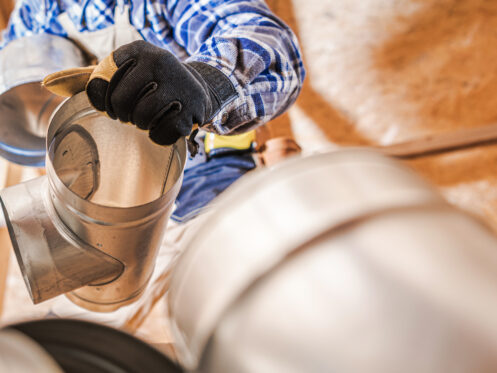What Role Does Sheet Metal Have in Modern HVAC Systems?
The central HVAC system in your Navarre, FL home contains a fair amount of sheet metal. Although HVAC air ducts are the most visible example of sheet metal’s use, these thin, flat pieces of metal exist in many other components. Sheet metal is both highly malleable and highly durable.
It can withstand extreme wind forces and hold up in harsh, humid conditions. Read on to discover the role that sheet metal plays in keeping you and your household comfortable and why it’s such an important part of your indoor climate control.
Air Delivery
Residential HVAC air ducts are usually made from one of four materials:
- Coated spring steel wire helix
- Fiberglass
- Fiberboard
- Sheet metal
Of these four, sheet metal is the most commonly used. Sheet metal tends to be less expensive than most other material types and it’s lightweight, easy to transport, and easy to install. HVAC equipment manufacturers and installers can use sheet metal for all duct trunks and pipes, HVAC air vents and grilles, plenums, flues, and air handling units. In these applications, sheet metal’s role is largely air delivery. When HVAC blower fans are in action, they move air through sheet metal return and supply ducts.
Venting
HVAC venting systems are also made of sheet metal. These vents route exhaust gases away from living areas and outdoors. If you have a fuel-burning furnace in your home, the carbon monoxide created during incomplete combustion moves through sheet metal before exiting the building.
Zoning and Air Balancing
Sheet metal also plays an important role in HVAC zoning. If you intend to zone your home heating and cooling system for efficiency, your installer will add sheet metal duct dampers and bypass ducts to your ductwork. When air is needed in any service area, the respective duct damper will lift to allow conditioned air to flow through. Bypass ducts open when duct dampers block the flow of air into any area so that static pressure doesn’t build.
When used for HVAC air delivery systems, sheet metal must be seamless, corrosion-resistant, and robust. Loose connections, gaps, perforations, and other openings decrease heating and cooling efficiency and indoor air quality (IAQ).
Heat Transfer
Surprisingly, sheet metal also plays a hand in heat transfer. Whether you use a heat pump or an air conditioner for cooling, its evaporator and condenser coils contain sheet metal. Ultra-thin pieces of sheet metal form the coils themselves and sheet metal fins surround them to facilitate air movement. Due to its high levels of thermal conductivity, copper is typically used for coil construction. Due to its low cost, flexibility, and remarkable efficacy in this application, aluminum is the go-to choice for coil fins.
Refrigerant Delivery
Copper sheet metal is used for AC and heat pump refrigerant lines. In this application, copper is valued for its strength and leak resistance, and for its ability to withstand both high heat and exceedingly low temperatures. After all, the copper refrigerant lines in your cooling system hold both icy, liquid refrigerant and refrigerant that travels as a piping-hot vapor gas.
Different Types of Sheet Metal Used in HVAC Systems
In addition to copper sheet metal, HVAC systems contain sheet metal made from:
- Galvanized steel
- Aluminum
- Stainless steel
Each material type has its own benefits and drawbacks and each works better in some applications than others.
Galvanized Steel
Zinc-coated or galvanized steel works well in HVAC ductwork due to its remarkable strength and durability. Its zinc-coating also makes it highly corrosion-resistant and well-suited to moist environments. Galvanized steel is a top choice for HVAC air ducts in Navarre given the region’s high humidity. In commercial HVAC systems, roof curbs or the raised metal frames used for mounting rooftop HVAC equipment are frequently comprised of galvanized steel as well.
Unfortunately, galvanized steel has a low thermal conductivity and is a poor insulator. Homeowners can overcome this shortcoming by insulating and sealing their galvanized steel ducts.
Aluminum
Though not as high-strength or durable as galvanized steel, aluminum has high thermal conductivity. Paired with its low cost, this attribute makes it more appealing than galvanized steel for many HVAC companies and homeowners. However, although aluminum sheet metal will lose less heating and cooling energy when distributing conditioned air, it can still benefit from duct sealing and insulation. Aluminum is primarily used for HVAC air ducts and coil fins.
Stainless Steel
Stainless steel contains minor amounts of chromium. Known for its mirror-like shine, stainless steel trumps galvanized steel in corrosion resistance. However, this material is usually only used for specialized components and is most often found in custom duct systems.
Different Options in Residential HVAC Ducting
HVAC ductwork is the one sheet metal application that homeowners have the most say in. After all, when shopping for heat pumps and air conditioners, few consumers ask about the sheet metal that cooling coils and coil fins are made from.
Given that HVAC air ducts generally last between 12 and 15 years, there will likely come a time when you have to replace the air ducts in your home. When you get ready for HVAC air duct replacement, you should consider multiple factors, such as humidity, cost, corrosion resistance, and the overall layout of your home.
For most homes, ductwork is manufactured by cutting, pressing, and then folding sheet metal into a desired shape. All sheep metal is malleable enough to achieve and hold a variety of forms. The four most common sheet metal shapes for HVAC ductwork are rectangular, round, oval, and spiral.
Rectangular Sheet Metal Ducts
Square or rectangular ducts work best in short, simple duct runs. They perform best in low-pressure systems. Rectangular ducts also take up less space than many of their alternatives which makes them ideal for use in tight or crowded areas.
Oval Sheet Metal Ducts
Often found in commercial and industrial facilities, flat, oval ducting is valued for its pressure-regulating abilities. Oval ducts lower the pressure of air during distribution for a smoother flow, fewer air leaks, and less overall duct wear. Given their low likelihood of developing perforations, gaps, and other openings, these ducts additionally promote higher indoor air quality.
Round Sheet Metal Ducts
Round sheet metal ducts offer efficient air delivery. Their joints fit seamlessly together and they have very few, internal surface variations that inhibit airflow. Round air ducts are a top choice for reducing duct-related energy loss, especially when paired with duct materials that have naturally high thermal conductivity. Given that round ducts are quick and easy to install, they typically cost less than their alternatives as well.
Spiral Sheet Metal Ducts
Spiral sheet metal ducts are cost-effective. They also have a limited likelihood of developing leaks. Like rectangular ducts, they work well in restricted areas. Property owners often choose spiral ducting to minimize HVAC noise. These ducts are well-known for promoting whisper-quiet HVAC operation.
For top-notch heating, cooling, and plumbing services in Navarre, FL, you can count on us. We also offer duct cleaning, indoor air quality improvements, thermostats, and ductwork. To find out more or schedule an appointment, get in touch with Paradise Home Services today.



